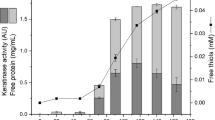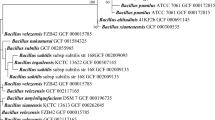Abstract
The non-spore forming Gram-positive actinomycetes Amycolatopsis keratiniphila subsp. keratiniphila D2T (DSM 44,409) has a high potential for keratin valorization as demonstrated by a novel biotechnological microbial conversion process consisting of a bacterial growth phase and a keratinolytic phase, respectively. Compared to the most gifted keratinolytic Bacillus species, a very large number of 621 putative proteases are encoded by the genome of Amycolatopsis keratiniphila subsp. keratiniphila D2T, as predicted by using Peptide Pattern Recognition (PPR) analysis. Proteome analysis by using LC–MS/MS on aliquots of the supernatant of A. keratiniphila subsp. keratiniphila D2T culture on slaughterhouse pig bristle meal, removed at 24, 48, 96 and 120 h of growth, identified 43 proteases. This was supplemented by proteome analysis of specific fractions after enrichment of the supernatant by anion exchange chromatography leading to identification of 50 proteases. Overall 57 different proteases were identified corresponding to 30% of the 186 proteins identified from the culture supernatant and distributed as 17 metalloproteases from 11 families, including an M36 protease, 38 serine proteases from 4 families, and 13 proteolytic enzymes from other families. Notably, M36 keratinolytic proteases are prominent in fungi, but seem not to have been discovered in bacteria previously. Two S01 family peptidases, named T- and C-like proteases, prominent in the culture supernatant, were purified and shown to possess a high azo-keratin/azo-casein hydrolytic activity ratio. The C-like protease revealed excellent thermostability, giving promise for successful applications in biorefinery processes. Notably, the bacterium seems not to secrete enzymes for cleavage of disulfides in the keratinous substrates.
Key points
• A. keratiniphila subsp. keratiniphila D2T is predicted to encode 621 proteases.
• This actinomycete efficiently converts bristle meal to a protein hydrolysate.
• Proteome analysis identified 57 proteases in its secretome.



Similar content being viewed by others
References
Al-Musallam AA, Al-Zarban SS, Fasasi YA, Kroppenstedt RM, Stackebrandt E (2003a) Amycolatopsis keratiniphila sp. nov., a novel keratinolytic soil actinomycete from Kuwait. Int J Syst Evol Microbiol 53:871–874. https://doi.org/10.1099/ijs.0.02515-0
Al-Musallam AA, Al-Zarban SS, Al-Sarawi HK, Kroppenstedt RM, Stackebrandt E, Fasasi YA (2003b) Influence of nutritional supplements on keratinolysis by Amycolatopsis keratiniphila. Indian J Exp Biol 41:870–874
Brandelli A, Daroit DJ, Riffel A (2010) Biochemical features of microbial keratinases and their production and application. Appl Microbiol Biotechnol 85:1735–1750
Brouta F, Descamps F, Monod M, Vermout S, Losson B, Mignon B (2002) Secreted metalloprotease gene family of Microsporum canis. Infect Immunity 70:5676–5683
Busk PK, Lange L (2013) Function-based classification of carbohydrate-active enzymes by recognition of short, conserved peptide motifs. Appl Environ Microbiol 79:3380–3391
Busk PK, Lange L (2015) Classification of fungal and bacterial lytic polysaccharide monooxygenases. BMC Genomics 16:368. https://doi.org/10.1186/s12864-015-1501-6
Chen X-L, Xie B-B, Bian F, Zhao G-Y, Zhao H-L, He H-L, Zhou B-C, Zhang Y-Z (2009) Ecological function of myroilysin, a novel bacterial M12 metalloprotease with elastinolytic activity and a synergistic role in collagen hydrolysis, in biodegradation of deep-sea high-molecular-weight organic nitrogen. Appl Environ Microb 75:1838–1844
Ding S, Sun Y, Chen H, Xu C, Hu Y (2019) An ultrasonic-ionic liquid process for the efficient acid catalyzed hydrolysis of feather keratin. Chin J Chem Engin 27:660–667
Espersen R (2018) Keratin2Protein: valorization of keratinous materials through microbial conversion. Dissertation, Technical University of Denmark
Espersen R, Falco FC, Hägglund P, Gernaey KV, Lantz AE, Svensson B (2020) Two novel S1 peptidases from Amycolatopsis keratiniphila subsp. keratiniphila D2T degrading keratinous slaughterhouse by-products. Appl Microbial Biotechnol 104:2513–2522
Falco FC (2018) Microbial degradation of keratin-rich porcine by-products for protein hydrolysate production: a process engineering perspective. Dissertation, Technical University of Denmark
Falco FC, Espersen R, Svensson B, Gernaey KV, Lantz AE (2019) An integrated strategy for the effective production of bristle protein hydrolysate by the keratinolytic filamentous bacterium Amycolatopsis keratiniphila subsp. keratiniphila D2T. Waste Manage 89:94–102
Gonzalo M, Espersen R, Al-Soud WA, Falco FC, Hägglund P, Sørensen SJ, Svensson B, Jacquiod S (2020) Azo-dying of α-keratin material improves microbial keratinase screening and standardization. Microbial Biotechnol 13:984–996
Grumbt M, Monod M, Yamada T, Hertweck C, Kunert J, Staib P (2013) Keratin degradation by dermatophytes relies on cysteine dioxygenase and sulfite efflux pump. J Invest Dermatol 133:1550–1555
Gupta R, Sharma R, Beg QK (2012) Revisiting microbial keratinases: next generation proteases for sustainable biotechnology. Crit Rev Biotechnol 33:1–13
Hassan MA, Abou-Fotouh D, Omer AM, Tamer TM, Abbas E (2020) Comprehensive insights into microbial keratinases and their implication in various biotechnological and industrial sectors: a review. Int J Biol Macromol 154:567–583
Huang Y, Busk PK, Herbst FA, Lange L (2015) Genome and secretome analyses provide insights into keratin decomposition by novel proteases from the non-pathogenic fungus Onygena corvina. Appl Microbiol Biotechnol 99:9635–9649
Huang Y, Lezyk M, Busk HFA, PK, Lange L, (2020) Novel keratinolytic enzymes, discovered from a talented and efficient bacterial keratin degrader. Sci Rep 10:10033
Joussin O, Léchenne BM, Capoccia S, Mignon B, Barblan J, Quadroni M, Monod M (2004) Multiplication of an ancestral gene encoding secreted fungalysin preceded species differentiation in the dermatophytes Trichophyton and Microsporum. Microbiology 150:301–310
Kang D, Huang Y, Nesme J, Herschend J, Jacquiod S, Kot W, Hansen LH, Lange L, Sørensen SJ (2021) Metagenomic analysis of keratin-degrading bacterial consortium provides insight into the keratinolytic mechanisms. Sci Total Environ 761:143281
Kim JS, Kluskens ID, De Vos WM, Huber R, Van der Oost J (2004) Crystal structure of fervidolysin from Fervidobacterium pennivorans, a keratinolytic related enzyme related to subtilisin. J Mol Biol 335:787–797
Lange L, Huang Y, Busk PK (2016) Microbial decomposition of keratin in nature – a new hypothesis of industrial relevance. Appl Microbiol Biotechnol 100:2083–2096
Lee CH, Kim MS, Chung BM, Leahy DJ, Coulombe PA (2012) Structural basis for the heteromeric assembly and perinuclear organization of keratin filaments. Nat Struct Mol Biol 19:707–715
Lombard V, Golaconda Ramulu H, Drula E, Coutinho PM, Henrissat B (2014) The carbohydrate-active enzymes database (CAZy) in 2013. Nucleic Acids Res 42:D490–D495
Mitsuiki S, Ichikawa M, Oka T, Sakay M, Moriyama Y, Sameshima Y, Goto M, Furukawa K (2004) Molecular characterization of a keratinolytic enzyme from an alkaliphilic Nocardiopsis sp TOA-L. Enzyme Microbial Technol 34:482–489
Nasipuri P, Herschend J, Brejnrod AD, Madsen JS, Espersen R, Svensson B, Burmølle M, Jacquiod S, Sørensen SJ (2020) Community-intrinsic properties enhance keratin degradation from bacterial consortia. PLoS One 15:e0228108
Peng Z, Zhang J, Du G, Chen J (2019) Keratin waste recycling based on microbial degradation: mechanisms and prospects. ACS Sust Chem 7:9727–9736
Prakash P, Jayalakshmi SK, Sreeramulu K (2010) Purification and characterization of extreme alkaline, thermostable keratinase, and keratin disulfide reductase produced by Bacillus halodurans PPKS-2. App Microbiol Biotechnol 87:625–633
Qiu J, Wilkens C, Barrett K, Meyer AS (2020) Microbial enzymes catalyzing keratin degradation: Classification, structure, function. Biotechnol Adv 44:107607. https://doi.org/10.1016/j.biotechadv.2020.107607
Rahayu S, Syah M, Suhartono T (2012) Degradation of keratin by keratinase and disulfide reductase from Bacillus sp MTS of Indonesian origin. Biocatal Agric Biotechnol 1:152–158
Rozs M, Manczinger L, Vágvölgyi C, Kevei F (2001) Secretion of a trypsin-like thiol protease by a new keratinolytic strain of Bacillus licheniformis. FEMS Microbiol Lett 205:221–224
Shao X, Ran L-Y, Liu C, Chen X-L, Zhang X-Y, Qin Q-L, Zhou B-C, Zhang Y-Z (2015) Culture condition optimization and pilot scale production of the M12 metalloprotease myroilysin produced by the deep-sea bacterium Myroides profundi D25. Molecules 20:11891–11901
Sharma S, Gupta A (2012) Coupled action of γ-glutamyl transpeptidase-glutathione and keratinase effectively degrades feather keratin and surrogate prion protein, Sup 35NM. Bioresour Technol 120:314–317
Shavandi A, Silva TH, Bekhit AEDA (2017) Keratin: dissolution, extraction and biomedical application. Biomater Sci 5:1699–1735
Silveira ST, Jaeger MK, Brandelli (2010) Kinetic data and substrate specificity of keratinase from Chryseobacterium sp. strain kr6. J Chem Technol Biotechnol 84:361–366
Wang B, Yang W, Mckittrick J, Myers MA (2016) Keratin: structure, mechanical properties, occurrence in biological organisms, and efforts at bioinspiration. Prog Mater Sci 76:229–318
Wink JM, Kroppenstedt RM, Ganguli BN, Nadkarni SR, Schumann P, Seibert G, Stackebrandt E (2003) Three new antibiotic producing species of the genus Amycolatopsis, Amycolatopsis balhimycina sp. nov., A. tolypomycina sp. nov., A. vancoresmycina sp. nov., and description of Amycolatopsis keratiniphila subsp. keratiniphila subsp. nov. and Amycolatopsis keratiniphila subsp nogabecina subsp. nov. System Appl Microbiol 26:38–46
Yang I, Wang H, Lv Y, Bai Y, Luo H, Shi P, Huang H, Yao B (2016) Construction of a rapid feather-degrading bacterium by overexpression of a highly efficient alkaline keratinase in its parent strain Bacillus amyloliquefaciens K11. J Agric Food Chem 64:78–84
Zoccola M, Auigi A, Patrucco A, Vineis C, Forlini F, Locatelli P, Sacchi M, Tonin C (2012) Microwave-assisted chemical-free hydrolysis of wool keratin. Text Res J 82:2006–2018
Acknowledgements
Lene Blicher is thanked for expert assistance with mass spectrometry and Karina Jansen for general technical assistance.
Funding
This work was funded by the Innovation Fund Denmark | The Program Commission on Health, Food and Welfare to the project Keratin2Protein (grant 1308-00015B) and joint (1/3) PhD stipends from DTU to RE and FCF. Center for Advanced Food Studies (LMC) is thanked for supporting the acquisition of the Bruker Daltonics Ultraflex II MALDI-TOF/TOF mass spectrometer. The Orbitrap Fusion Tribrid Mass Spectrometer was granted by the Villum Foundation.
Author information
Authors and Affiliations
Contributions
RE and BS conceived the review. YH and LL performed the PPR analysis. FCF and KVG contributed by biological processing experiments. RE, PH, and BS conducted proteome analysis. RE and BS wrote the paper with input from LL, YH, FCF, and KVG. All authors have read and approved the manuscript.
Corresponding author
Ethics declarations
Ethical approval
This article does not contain any studies with human participants or animals performed by any of the authors. Safety precautions important for man and animals are taken into account when concluding from the results achieved.
Conflict of interests
The authors declare no competing interests.
Additional information
Publisher's note
Springer Nature remains neutral with regard to jurisdictional claims in published maps and institutional affiliations.
Supplementary Information
Below is the link to the electronic supplementary material.
Rights and permissions
About this article
Cite this article
Espersen, R., Huang, Y., Falco, F.C. et al. Exceptionally rich keratinolytic enzyme profile found in the rare actinomycetes Amycolatopsis keratiniphila D2T. Appl Microbiol Biotechnol 105, 8129–8138 (2021). https://doi.org/10.1007/s00253-021-11579-2
Received:
Revised:
Accepted:
Published:
Issue Date:
DOI: https://doi.org/10.1007/s00253-021-11579-2




